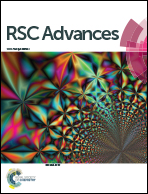Bio-doping of regenerated silk fibroin solution and films: a green route for biomanufacturing†
Abstract
Silk fibroin (SF) is a natural biocompatible material that can be integrated in a variety of photonic systems and optoelectronics: i.e. organic lasing from dye-doped nano-structured silk film. In this context, biological incorporation of doping molecules into SF by means of feeding silk worms with dyes to their diet could be an innovative and eco-sustainable approach to obtain doped SF substrates, thus avoiding additional chemical processes and post-treatments of the protein solution. In the present work, we demonstrated that SF regenerated solutions and films containing rhodamine B (RhB) could be successfully obtained from the cocoons of Bombyx mori fed with a RhB-added diet (RhB-md-SF). Comparative analyses of optical and vibration characteristics of the RhB-md-SF solution and films with those of white SF blended with RhB (RhB-d-SF) revealed significant differences, suggesting that the silkworm's metabolism could be involved in the binding mechanism of SF with RhB. In conclusion, we observed that the doping diet is a promising method for the green fabrication of SF-based optically active materials, and it opens novel routes for silk-based biophotonics.


 Please wait while we load your content...
Please wait while we load your content...